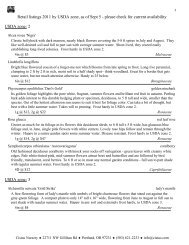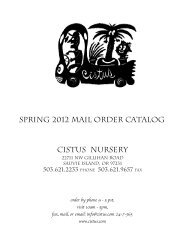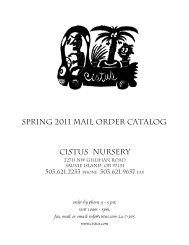1 Retail listings 2012 by USDA zone, as of April 5 ... - Cistus Nursery
1 Retail listings 2012 by USDA zone, as of April 5 ... - Cistus Nursery
1 Retail listings 2012 by USDA zone, as of April 5 ... - Cistus Nursery
Create successful ePaper yourself
Turn your PDF publications into a flip-book with our unique Google optimized e-Paper software.
<strong>Retail</strong> <strong>listings</strong> <strong>2012</strong> <strong>by</strong> <strong>USDA</strong> <strong>zone</strong>, <strong>as</strong> <strong>of</strong> <strong>April</strong> 5 - ple<strong>as</strong>e check for current availability<br />
Agave murpheyi murphey's agave<br />
Sweet little agave, from mid elevation deserts <strong>of</strong> central Arizona into Sonora, <strong>of</strong>ten found <strong>as</strong>sociated with<br />
Native American sites. To 18", or 2 feet at most, with narrow, upright leaves, slightly recurved and steel to<br />
powder blue. Offsetting fairly quickly. The eventual flowers also produce tiny bulbils -- <strong>as</strong> the song goes -which<br />
might explain its being spread <strong>by</strong> people in the early days. Because <strong>of</strong> its drier habitats we keep ours in<br />
pots with very well drained soil, or only in the most exposed are<strong>as</strong> <strong>of</strong> our garden and growing in true grit. Full<br />
sun. Again, dry conditions with an occ<strong>as</strong>ional spl<strong>as</strong>h <strong>of</strong> summer water. Cold hardy into upper <strong>USDA</strong> <strong>zone</strong> 7 if<br />
dry.<br />
2g @ $28 Agavaceae<br />
Agave ovatifolia whale's tongue agave<br />
One <strong>of</strong> the most beautiful century plants, found in the Sierra de Lampazos in the early 80s <strong>by</strong> the late great<br />
plantsman, Lynn Lowrey and only named in 2004 <strong>by</strong> agave-ist Greg Starr. Growing in a limited range <strong>of</strong><br />
pinyon/juniper/oak country above 8000 ft, the exceedingly wide, beautifully toothed and chalky blue rosettes<br />
can reach over 5 ft in width giving the appearance <strong>of</strong> a much more tropical species. H<strong>as</strong> proven to be one <strong>of</strong><br />
the best performers where cold and wet is experienced in winter and h<strong>as</strong>, thus far, proven hardy to 0F, <strong>USDA</strong><br />
<strong>zone</strong> 7, or even a bit lower. Sun to dappled shade; drainage is always a plus.<br />
6in @ $17, 2g @ $32 Agavaceae<br />
Agave parr<strong>as</strong>ana<br />
This Mexican species is most e<strong>as</strong>ily identified <strong>by</strong> its thick triangular leaves, beautifully marked blue-green in<br />
color, arranged in a striking rosette and edged with equally thick brown and white spines. Plants form low<br />
dense mounds, each rosette eventually me<strong>as</strong>uring 2 ft x 2 ft and, in time, sending up 12 ft branched flower<br />
spikes <strong>of</strong> warm yellow blushed apricot. Best in mineral soil, sharp drainage, full sun. This represents a high<br />
elevation collection at over 8,500 ft that h<strong>as</strong> thus far withstood between 0 and 10F, <strong>USDA</strong> <strong>zone</strong> 7, with<br />
overhead protection from excess winter moisture. Stunning pot plant or container specimen.<br />
6in @ $16 Agavaceae<br />
Agave parviflora - Ru<strong>by</strong>, AZ<br />
A jewel-like miniature agave from the dry gr<strong>as</strong>slands <strong>of</strong> southern Arizona and adjacent Sonora, a habitat that<br />
includes D<strong>as</strong>ylirion wheeleri and the famed Opuntia violacea v. santa rita, a rich area where we have selected<br />
forms <strong>of</strong> heucher<strong>as</strong>, Zauschneria arizonica, and numerous desert ferns. Rosettes are only 6-8" with narrow<br />
leaves, deep green marked white, and curled filifers that make it an intriguing plant for container or garden.<br />
The flowering stalks are tall and narrow; the unusual, creamy flowers are tinted red, making hummingbirds<br />
very happy. Provide excellent drainage in bright light to only the lightest <strong>of</strong> shade for best form. The habitat<br />
h<strong>as</strong> dry winters and thunderstorm laden summers so these plants are best well watered in summer and kept dry<br />
in winter, though plants in our Portland garden have been quite happy for some years in a stone wall with no<br />
cover. Frost hardy from 0 to 10F, <strong>USDA</strong> <strong>zone</strong> 7; colder if kept winter dry.<br />
4in @ $16, 2g @ $15 Agavaceae<br />
<strong>Cistus</strong> <strong>Nursery</strong> ◆ 22711 NW Gillihan Rd ◆ Portland, OR 97231 ◆ (503) 621-2233 ◆ info@cistus.com<br />
64







